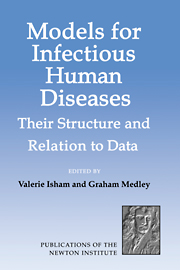Book contents
- Frontmatter
- Contents
- Introduction
- Participants
- Non-Participant Contributors
- Part 1 Transmissible diseases with long development times and vaccination strategies
- Part 2 Dynamics of immunity (development of disease within individuals)
- Evolutionary dynamics of HIV infections
- Statistical models for analysis of longitudinal, CD4 data
- Some mathematical and statistical issues in assessing the evidence for acquired immunity to schistosomiasis
- Virulence and transmissibility in P. falciparum malaria
- Invited Discussion
- Invited Discussion
- Invited Discussion
- Lifespan of human T lymphocytes
- Diversity and virulence thresholds in AIDS
- Statistical analysis of AZT effect on CD4 cell counts in HIV disease
- Modeling progression of HIV infection: staging and the Chicago MACS cohort
- The interpretation of immunoepidemiological data for helminth infections
- The distribution of malaria parasites in the mosquito vector: consequences for assessing infection intensity in the field
- When susceptible and infective human hosts are not equally attractive to mosquitoes: a generalisation of the Ross malaria model
- The dynamics of blood stage malaria: modelling strain specific and strain transcending immunity
- Part 3 Population heterogeneity (mixing)
- Part 4 Consequences of treatment interventions
- Part 5 Prediction
Invited Discussion
Published online by Cambridge University Press: 04 August 2010
- Frontmatter
- Contents
- Introduction
- Participants
- Non-Participant Contributors
- Part 1 Transmissible diseases with long development times and vaccination strategies
- Part 2 Dynamics of immunity (development of disease within individuals)
- Evolutionary dynamics of HIV infections
- Statistical models for analysis of longitudinal, CD4 data
- Some mathematical and statistical issues in assessing the evidence for acquired immunity to schistosomiasis
- Virulence and transmissibility in P. falciparum malaria
- Invited Discussion
- Invited Discussion
- Invited Discussion
- Lifespan of human T lymphocytes
- Diversity and virulence thresholds in AIDS
- Statistical analysis of AZT effect on CD4 cell counts in HIV disease
- Modeling progression of HIV infection: staging and the Chicago MACS cohort
- The interpretation of immunoepidemiological data for helminth infections
- The distribution of malaria parasites in the mosquito vector: consequences for assessing infection intensity in the field
- When susceptible and infective human hosts are not equally attractive to mosquitoes: a generalisation of the Ross malaria model
- The dynamics of blood stage malaria: modelling strain specific and strain transcending immunity
- Part 3 Population heterogeneity (mixing)
- Part 4 Consequences of treatment interventions
- Part 5 Prediction
Summary
Parasite Diversity and Parasite Coexistence
These papers deal with different aspects of understanding how hosts cope with the diversity of antigenic challenges that pathogens provide. These comments examine common threads underlying three of the presentations and describe some recent work on the more general problem of the diversity of pathogens that any host population can sustain.
The work of Martin Nowak and his colleagues at Oxford, Imperial College and Amsterdam University epitomizes the challenges that mathematical models present to empirical epidemiologists. As with other recent work on the mathematics of the immune system and infection with HIV (McLean 1993), the work suggests alternative interpretations of epidemiological data and has stimulated the collection (and analysis) of data not normally collected by immunologists and clinicians. At the heart of the Nowak model is the interaction between the diversity of HIV quasi-species in individual patients and the ability of the host to produce a sufficient diversity of antigens to cope with this. At a crucial level of quasi-species diversity, the diversity threshold, the immune system is overwhelmed, CD4 counts decline precipitously and the patient succumbs to full-blown AIDS. The length of time until this occurs is dependent upon a variety of factors, but most importantly upon the replication and mutation rate of the virus, and upon the host's ability to mount an efficient and diverse immune response. My main questions are about this diversity threshold; the diversity levels presented in the model seem much higher than the diversity levels observed in individually infected HIV/AIDS patients.
- Type
- Chapter
- Information
- Models for Infectious Human DiseasesTheir Structure and Relation to Data, pp. 184 - 188Publisher: Cambridge University PressPrint publication year: 1996

